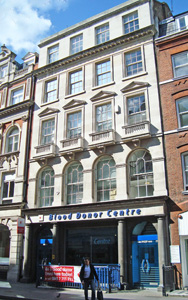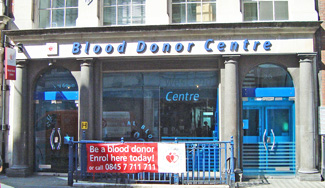St Pancras Chest Clinic
26 Margaret Street, W1W 8NB
Medical
dates:
Medical
character:
Specialist (Out-Patients only)
The Infirmary for Consumption
and Diseases of the Chest and Throat was founded in 1847. It was
located in a building in Margaret Street which had originally been a
workhouse and also used as a dead house for the poor.
The Infirmary had no beds; it was essentially an out-patients dispensary which provided medical relief for the poor suffering from tuberculosis and other diseases of the chest. It was staffed by physicians who also visited patients in their own homes.
In 1887, a time when there was an on-going conflict between orthodox practitioners and homeopaths, two physicians - Apollinaris Victor Jagielski and Thomas Charles Marsh, both medically qualified - were accused by other members of the medical staff of treating patients homeopathically. They were asked to desist. However, a large injection of money into the coffers of the Infirmary enabled homeopathic supporters Robert Ellis Dudgeon and Edmund Beckett, Baron Grimthorpe, to join the governing body of the Infirmary. In April, seven members of the medical staff resigned in protest over the adoption of a resolution made at a special meeting of the Governors, which allowed homeopaths to take and hold office on the staff. Within one month three medical officers were appointed - two of whom were members of the British Homeopathic Society (founded in 1844 by Dr Frederic Hervey Foster Quin) and the third an allopath.
In 1888 an election was held to fill the vacant medical posts and two more homeopaths were thereby appointed.
Until 1908 the Infirmary was also known as the Margaret Street Hospital for Consumption and Diseases of the Chest.
The Hospital was rebuilt in 1914. It was officially reopened by the Princess Royal on 4th May 1915 as the Margaret Street Hospital for Consumption.
The basement contained a large Out-Patients Hall with consulting rooms. There were also W.C.s and dressing rooms for men and women. In one room was a model of the Fairlight Sanatorium in Hastings, which had 51 beds for male patients referred from the Hospital. Female patients were sent to St Catherine's Home, a sanatorium at Burghfield Common, near Reading.
The ground floor contained offices and a dispensary. The upper part of the building, which had a separate entrance, was sublet.
Restricted to the treatment of out-patients only, it opened daily at 1.30. The varied special forms of treatment provided included tuberculin and contratoxin. Many patients were enabled to continue working or attend school.
By the 1920s it was known as the Margaret Street Hospital.
On 4th November 1936 a new X-ray Department was officially opened by the Marchioness of Titchfield. In the spring of 1937 a Hay Fever Ionization Clinic opened.
In 1948 the Hospital joined the NHS under the control of the Archway Group Hospital Management Committee, part of the North West Metropolitan Regional Hospital Board. It was renamed the Margaret Street Hospital for Diseases of the Chest, and continued to treat patients with tuberculosis, mainly residents of the Borough of St Pancras. Those who needed in-patient treatment were referred to the 92-bed TB Unit at the Whittington Hospital.
By the early 1950s the Hospital had been renamed the St Pancras Chest Clinic.
During 1964, despite the availability of vaccination and anti-tuberculosis drugs, the Clinic treated 121 men and 50 women, and 8 boys and 6 girls with pulmonary TB, and 7 men and 6 women with non-pulmonary TB.
The Clinic closed in the late 1960s.
Present status (April 2009)
The Infirmary had no beds; it was essentially an out-patients dispensary which provided medical relief for the poor suffering from tuberculosis and other diseases of the chest. It was staffed by physicians who also visited patients in their own homes.
In 1887, a time when there was an on-going conflict between orthodox practitioners and homeopaths, two physicians - Apollinaris Victor Jagielski and Thomas Charles Marsh, both medically qualified - were accused by other members of the medical staff of treating patients homeopathically. They were asked to desist. However, a large injection of money into the coffers of the Infirmary enabled homeopathic supporters Robert Ellis Dudgeon and Edmund Beckett, Baron Grimthorpe, to join the governing body of the Infirmary. In April, seven members of the medical staff resigned in protest over the adoption of a resolution made at a special meeting of the Governors, which allowed homeopaths to take and hold office on the staff. Within one month three medical officers were appointed - two of whom were members of the British Homeopathic Society (founded in 1844 by Dr Frederic Hervey Foster Quin) and the third an allopath.
In 1888 an election was held to fill the vacant medical posts and two more homeopaths were thereby appointed.
Until 1908 the Infirmary was also known as the Margaret Street Hospital for Consumption and Diseases of the Chest.
The Hospital was rebuilt in 1914. It was officially reopened by the Princess Royal on 4th May 1915 as the Margaret Street Hospital for Consumption.
The basement contained a large Out-Patients Hall with consulting rooms. There were also W.C.s and dressing rooms for men and women. In one room was a model of the Fairlight Sanatorium in Hastings, which had 51 beds for male patients referred from the Hospital. Female patients were sent to St Catherine's Home, a sanatorium at Burghfield Common, near Reading.
The ground floor contained offices and a dispensary. The upper part of the building, which had a separate entrance, was sublet.
Restricted to the treatment of out-patients only, it opened daily at 1.30. The varied special forms of treatment provided included tuberculin and contratoxin. Many patients were enabled to continue working or attend school.
By the 1920s it was known as the Margaret Street Hospital.
On 4th November 1936 a new X-ray Department was officially opened by the Marchioness of Titchfield. In the spring of 1937 a Hay Fever Ionization Clinic opened.
In 1948 the Hospital joined the NHS under the control of the Archway Group Hospital Management Committee, part of the North West Metropolitan Regional Hospital Board. It was renamed the Margaret Street Hospital for Diseases of the Chest, and continued to treat patients with tuberculosis, mainly residents of the Borough of St Pancras. Those who needed in-patient treatment were referred to the 92-bed TB Unit at the Whittington Hospital.
By the early 1950s the Hospital had been renamed the St Pancras Chest Clinic.
During 1964, despite the availability of vaccination and anti-tuberculosis drugs, the Clinic treated 121 men and 50 women, and 8 boys and 6 girls with pulmonary TB, and 7 men and 6 women with non-pulmonary TB.
The Clinic closed in the late 1960s.
Present status (April 2009)
The building now contains the London West End Blood Donor Centre.

No. 26 Margaret Street (above and below).

(Author unstated) 1887 Resignation of the Medical Staff of the Margaret Street Infirmary for Consumption. British Medical Journal 1 (1366), 541.
(Author unstated) 1887 The Margaret Street Infirmary. British Medical Journal 1 (1367), 591.
(Author unstated) 1908 Medical Education in London. London, Conference of Deans of the Metropolitan Schools of Medicine. p.124.
(Author unstated) 1915 Opened by the Princess Royal. The Graphic, 8th May, 602.
(Author unstated) 1915 Hospital World. Margaret Street Hospital for Consumption. British Journal of Nursing (July), 98.
(Author unstated) 1936 Medical News. British Medical Journal 2 (3958), 1011.
Chou J-Y 2016 Reforming towards a scientifix medicine and a changing social idenity: British homoeopathy 1866-1893. Thesis, University College London. 313-322.
Davies PDB 1963 Some problems of chest diseases in immigrants. Proceedings of the Royal Society of Medicine 56, 565-566.
Franklin P 1939 Management of a hay-fever ionization clinic. British Medical Journal 1 (4086), 871-872.
http://archivehistoricengland.org.uk (1)
http://archivehistoricengland.org.uk (2)
http://sueyounghistories.com
https://api.parliament.uk
www.ucl.ac.uk
Return to home page